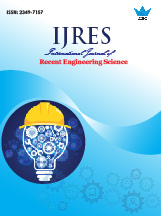The Initial Design Analysis Of 80 Meters Corvette Ship Propulsion System
 |
International Journal of Recent Engineering Science (IJRES) | 
|
| © 2019 by IJRES Journal | ||
| Volume-6 Issue-2 |
||
| Year of Publication : 2019 | ||
| Authors : Arica Dwi Susanto |
||
| DOI : 10.14445/23497157/IJRES-V6I2P101 |
Citation
MLA Style :Arica Dwi Susanto "The Initial Design Analysis Of 80 Meters Corvette Ship Propulsion System" International Journal of Recent Engineering Science 6.2(2019):1-8.
APA Style :Arica Dwi Susanto, The Initial Design Analysis Of 80 Meters Corvette Ship Propulsion System. International Journal of Recent Engineering Science, 6(2),1-8.
Abstract
The Indonesian Navy currently has several types of warships. One of which is a type of corvette ship, which is a fully armored ship with a CODOG (Combined Diesel Or Gas Turbine) propulsion system; the current condition is that the age of the ship has already been 20 years; thus, it can not reach maximum speed. In the design of this corvette ship, the stimulation system used the CODAD system (Combine Diesel and Diesel). Diesel is suitable for the development of Indonesian technology today because diesel engine drives have a high efficiency than others. Based on the results of the matching research between engines, propellers, and hull, the speed of the ship was obtained, which was 31.346 knots on 95% BMEP, so the condition was still safe for engines while propellers with 5% BMEP power reserves for terrible weather conditions.
Reference
[1] Adumene, NSAS 2015, `Predictive Analysis of Bare-Hull Resistance of a 25,000 Dwt Tanker Vessel`, International Journal of Engineering and Technology, pp. 194-198.
[2] Amin, JKAA 2014, `Performance of VLCC Ship with Podded Propulsion System and Rudder`, International Society of Ocean, Mechanical and Aerospace Scientists and Engineers, pp. 1-7.
[3] Andersen, JP 1994, Hydrodynamic of Ship Propeller, Elsevier, Cambridge.
[4] Anthony F. Molland, SR 2011, Ship Resistance and Propulsion, Practical Estimation of Ship Propulsive Power, United States of America.
[5] Atreyapurapu.et.al, K 2014, `Simulation of a Free Surface Flow over a Container Vessel Using CFD`, International Journal of Engineering Trends and Technology, pp. 334-339.
[6] Bartee, DL 1975, `Design of Propulsion Systems for HighSpeed Craft`, The Society of Naval Architects and Marine Engineers, pp. 1-17.
[7] Bertram, HSAV 1998, Ship Design for Efficiency and Economy, Butterworth-Heinemann, Great Britain.
[8] Bertram, V 2000, Practical Ship Hydrodynamic, ButterworthHeinemann, Great Britain.
[9] Charchalis, A 2013, `Designing Constraints in Evaluation of Ship Propulsion Power`, Journal of KONES Powertrain and transport, pp. 1-6.
[10] Chun.et.al., HH 2013, `Experimental investigation on sternboat deployment system and operability for Korean coast guard ship`, International Journal Naval Architecture Ocean Engineering, pp. 488-503.
[11] D`arcalengelo, AM 1969, Ship Design and Construction, Professor of Naval Architecture and Marine Engineering University of Michigan, Michigan.
[12] Degiuli.et.al., N 2017, `Increase of Ship Fuel Consumption Due to the Added Resistance in Waves`, Journal of Sustainable Development of Energy, Water and Environment Systems, pp. 1-14.
[13] Gerr, D 2001, Propeller Handbook, International Marine, United Stated.
[14] Guldhammer, HE 1974, Ship Resistance, Akademisk Forlag, Copenhagen.
[15] Harrington, RL 1992, Marine Engineering, Revised, Subsequent edn, The Society of Naval Architects and Marine Engineers , Jersey City, United States.
[16] Harvald, SA 1992, Resistance and Propulsion of Ships, John Wiley and Sons, New York.
[17] Herdzik, J 2013, `Problems of propulsion systems and main engines choice for offshore support vessels`, Scientific Journals Zeszyty Naukowe, vol 2, no. 1733-8670, pp. 45-50.
[18] Kleppesto, K 2015, `Empirical Prediction of Resistance of Fishing Vessels`, NTNU Trondheim Norwegian University of Science And Technology, pp. 1-87.
[19] Kowalski, A 2013, `Cost optimization of marine fuels consumption as an important factor of control ship`s sulfur and nitrogen oxides emissions`, Scientific Journals, pp. 94-99.
[20] Kuiper, G 1992, The Wageningen Propeller Series, MARIN, Netherland.
[21] Lewis, EV 1988, Principles of Naval Architecture Second Revision, The Society of Naval Architecs and Marine Engineers, New Jersey.
[22] Premchand, PK 2015, `Numerical Investigation of the Influence of Water Depth on Ship Resistance `, International Journal of Computer Applications, pp. 1-8.
[23] Samson, DIFAN 2015, `Effect of Fluid Density On Ship Hull Resistance and Powering`, International Journal of Engineering Research and General Science, pp. 615-630.
[24] Samuel, MI 2015, `An Investigation Into The Resistance Components of Converting a Traditional Monohull Fishing Vessel Into Catamaran Form`, International Journal of Technology, pp. 1-10.
[25] Sladky, J 1976, Marine Propulsion, The Winter Annual Meeting of The American Society of Marine Engineers, New York.
[26] Susanto.et.al., AD 2017, `Analysis of The Propulsion System Towards The Speed Reduction of Vessels Type PC-43`, International Journal of Engineering Research and Application, pp. 8-15.
[27] Tabaczek, JK 2014, `Coefficients of Propeller-hull Interaction in Propulsion System of Inland Waterway Vessels with Stern Tunnels`, International Journal on Marine Navigation and Safety of Sea Transportation, pp. 1-8.
[28] Tupper, EC 1975, Introduction to Naval Architecture, Naval Architecture for Marine Engineers, Great Britain.
[29] Tupper, KR 2001, Basic Ship Theory, Great Britain, Inggris.
[30] Watson, DGM 1998, Practical Ship Design, Elsevier Science Ltd, Netherlands.
[31] WPA Van Lamerren, TL 1984, Resistance Propulsion and Steering of Ship, Harlem Holland, Holland.
[32] Zelazny, K 2014, `A method of Calculation of Ship Resistance on Calm Water Useful at Preliminary Stages of Ship Design`, Scientific Journal Maritime University of Szczecin, pp. 125-130.
[33] ?elazny, K 2015, `An Approximate Method For Calculation of Mean Statistical Value of Ship Service Speed On a Given Shipping Line, Useful In Preliminary Design Stage`, Polish Maritime Research, pp. 28-35.
Keywords
Ship Resistance, Power Boats, Propeller, Ship Propulsion, Engine Propeller Matching.
